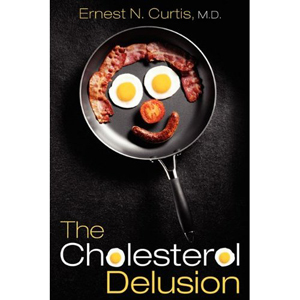February 28, 2011
The Cholesterol Delusion: A Book Review

By Michael D. Shaw
The Cholesterol Delusion
by Ernest N. Curtis, M.D.
Dog Ear Publishing, 168 pp., $13.99
ISBN 978-160844-748-0
While there are a growing number of voices speaking out against the cholesterol theory of heart disease, this new work from cardiologist Ernest N. Curtis, M.D. promises to both energize the cholesterol skeptics, as well as educate a whole new crop of health-conscious individuals.
Curtis introduces his main premise right on page 3 (of the paperback edition)…
The Cholesterol Theory and the Diet-Heart theory [of coronary heart disease] are scientifically bankrupt. Moreover, the continued presentation of these unproven theories as established fact in both the popular press and medical journals causes harm by diverting attention from the true causes and wasting billions of dollars on useless research. The Cholesterol Theory is a near-perfect medical analog of the Emperor’s New Clothes: When examined closely, there is nothing there.
Subsequent chapters lead the reader to this inevitable conclusion. Curtis begins with a brief description of how the heart works, and what happens during a heart attack. He then covers the physiological role of cholesterol, and details a host of facts that would seem to contradict the Cholesterol Theory. One stands out in particular:
Victims of heart attacks have cholesterol levels evenly distributed throughout the range of values. In fact, more than half of heart attack victims have cholesterol levels in the low normal range.
A goodly portion of The Cholesterol Delusion is devoted to a searing critique of the major studies that supposedly prove the theory. To strengthen his case, Curtis explains the limitations of epidemiology, and then will shock many readers with his revelation that cause of death—a fundamental parameter in any epi study—is itself wildly inaccurate. Some estimates peg the error rate in excess of 50%.
In many cases, the physician has no idea what actually caused the death of his patient, but is forced to reach a finding on the death certificate, in accordance with the diagnostic codes listed in the International Classification of Diseases (ICD-9). “Old age” and “natural causes” are not included, so absent other findings, most doctors in the United States resort to a default diagnosis of coronary heart disease or atherosclerotic heart disease.
This is a safe bet since virtually every elderly person has some degree of atherosclerosis or coronary heart disease. Ever hear of garbage in/garbage out? Bear this in mind next time someone tells you that heart disease is the “number one killer” in the US.
Curtis goes on to assure us that the inaccuracy of cause of death numbers is by no means confined to the United States.
Diet-Heart proponents often point to the low fat-diet of the Japanese and their low incidence of heart disease as a proof of their theory. Yet, the Japanese have an enormously higher death rate from stroke than us high-fat diet Americans. This is perplexing since the diseases are quite similar in etiology, albeit occurring in two different areas of the body.
This seeming paradox is explained when one discovers that in Japanese culture, death from a bad heart is very undesirable, but death from a brain disorder is more honorable, and a sign of intelligence.
Then there’s the so-called French paradox whereby the high-fat French diet produces a low incidence of coronary heart disease. The most common explanation for this is their greater consumption of red wine—a hypothesis which was widely proffered, with absolutely no scientific proof.
As you are now familiar with the unreliability of cause of death statistics, you will probably not be surprised to learn that the default diagnoses in France are myocarditis or hypertensive heart disease, rather than coronary heart disease. French paradox, indeed.
The book’s three appendices are focused on two supposedly definitive proofs of the Cholesterol Theory—the Lipid Research Clinics Trial and the Helsinki Heart Study—along with an informative section on how to read a medical journal report. Curtis’ dismantling of these two studies is masterful, and easily understood by lay readers.
Of course, no book entitled The Cholesterol Delusion would be complete without a section on statin drugs. Curtis details the side effects and politics behind their rise to become the number one class of drugs, as well as their ineffectiveness in preventing heart disease—although they do lower cholesterol.
Perhaps the sentence Curtis most enjoyed writing in the entire book is this:
What a delicious irony that the final proof that cholesterol has nothing to do with coronary heart disease would come from trials of drugs specifically designed to lower cholesterol.
As you might expect, he dismisses the “good” and “bad” cholesterol modification to the theory as simply a desperate attempt by proponents to explain away the mounting and massive contradictory data. The charade continues since LDL (“bad cholesterol”) does not correlate too well with atherosclerosis, so now “oxidized” LDL is the culprit. Do the proponents even believe this stuff anymore?
First time author Ernest Curtis, M.D. delivers a winner. Check it out.

